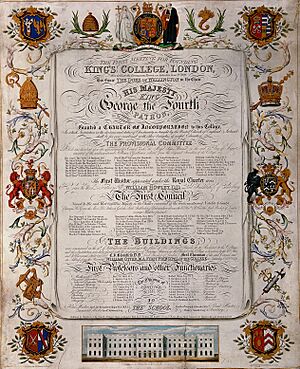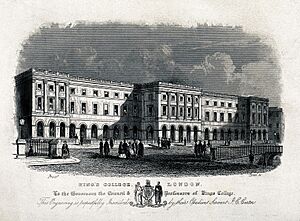History of King's College London facts for kids

King's College London has a history of over 190 years! It started as a 'university college' in 1829, given special permission by the King. It became a full 'university' in 1836 as part of the University of London. The story of King's also includes its medical schools, like the GKT School of Medical Education. One of these, St Thomas's Hospital Medical School, has been teaching medicine since at least 1561. St Thomas' Hospital itself is even older, dating back to 1173.
Contents
19th century: How King's College London Began
Founding a New College
King's College was created in 1829 because of a big disagreement about another new college. This other college, "London University" (now University College London), was started in 1826. It was open to everyone, including non-Anglican Christians and Jewish people, and didn't focus on religion. Some people called it "the godless college."
This made many religious people unhappy. In 1826, a man named Hugh James Rose suggested creating a new college that would be based on Christian principles. Soon after, letters in a newspaper called for a "true and genuine 'London University'" that would have professors who believed in the state's religion. This new college would be called "The College of King George the IVth" and would have religion as its "Rock" and the Church of England as its "wall of strength."
In 1828, George D'Oyly explained the idea for King's College. It would teach modern subjects, just like the other London University, but would have a strong Christian focus. This idea convinced the Prime Minister, the Duke of Wellington, to support the plan.
The King's College project officially began at a public meeting on June 21, 1828. The Prime Minister led the meeting, and many important religious leaders were there. They decided to create the college, ask the King to name it 'King's College, London', and start raising money. They also said that while the college would be Anglican and its professors would be members of the Church of England, students of any religion could attend, as long as they followed the college rules.
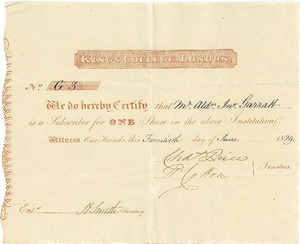
At this meeting, about £20,000 was promised, and by early July, this grew to over £50,000. However, some supporters later withdrew their pledges because the Duke of Wellington also supported rights for Irish Catholics.
Many places were considered for King's, including Buckingham Palace. In December 1828, it was suggested that the college be built next to the unfinished Somerset House, near the River Thames. This was accepted, even though some worried about the nearby slums and theaters. The land was given in June 1829. The architect Robert Smirke was chosen to design the building.
King George IV officially granted a royal charter for 'King's College, London' on August 14, 1829. This document stated the college's purpose: to educate young people in "Literature and Science" and also teach "the doctrines and duties of Christianity."
The college was set up as a business, where people who invested money could get a share of the profits, though no profits were ever paid out. The Archbishop of Canterbury was appointed as a special overseer for the college.
Construction began in November 1829. The main building, including the hall and chapel, was ready for the college's opening on October 8, 1831.
The Famous Duel of 1829
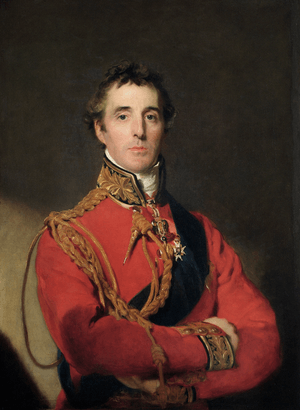
The Duke of Wellington supported both the Anglican King's College London and a new law that would give Catholics more rights. This upset George Finch-Hatton, 10th Earl of Winchilsea. Winchilsea wanted King's to be like Oxford and Cambridge, where only members of the Church of England could study.
Winchilsea and other supporters stopped backing King's College London because of Wellington's support for Catholic rights. Winchilsea publicly accused Wellington of not being sincere in his support for King's. He even wrote that Wellington had "insidious designs" to bring "Popery" (Catholicism) into the government.
This led to a heated argument. Wellington accused Winchilsea of making "disgraceful and criminal" accusations. When Winchilsea refused to take back his words, Wellington, who had never fought a duel before, demanded a fight.
The duel happened in Battersea Fields on March 21, 1829. Winchilsea chose not to fire his pistol. Wellington aimed and fired wide, missing on purpose. Honor was satisfied, and Winchilsea later apologized. This "Duel Day" is still celebrated at King's every year with special events.
Early Years and Growth
King's College opened in October 1831. William Otter, a religious leader, became the first Principal. The college welcomed students of all religions, even though its leaders and professors had to be members of the Church of England. Students had to attend Chapel.
King's had two main parts: a senior department for older students and a junior department, called King's College School, for younger pupils. The junior school started with 85 pupils and quickly grew. It moved to Wimbledon in 1897 and is no longer part of King's College London.
In the senior department, students could take a general course, a medical course, or other subjects like law and languages. In 1833, King's started awarding its own qualification, the Associate of King's College (AKC). This course, which covers ethics and religion, is still offered today.
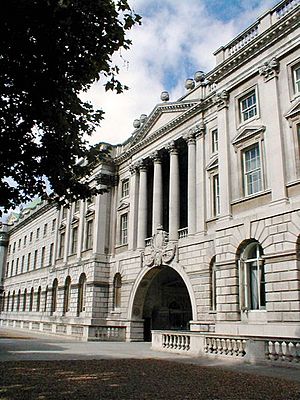
In 1835, the river-facing part of the college building was finished. Student numbers in the senior department didn't grow much at first, and the medical school faced some challenges. However, the appointment of Charles Wheatstone as a professor of Experimental Philosophy was very important.
At this time, neither King's nor "London University" could award degrees. In 1835, the government decided to create a separate board to grant degrees. This board became the University of London in 1836. The original "London University" became University College, London (UCL). King's became one of the colleges connected to this new University of London.
In 1838, King's started the second engineering course in Britain, which was the oldest in the country until it closed in 2013. King's also helped pioneer the study of English Literature as its own subject.
Mid-19th Century Developments
In 1839, the first degrees from the University of London were given to students from King's and UCL. King's also made an agreement with the University of Edinburgh so medical students could study at King's for most of their degree.
In 1840, King's opened its own hospital in a poor area of London. This hospital later moved to Denmark Hill in 1913. When Joseph Lister became a professor in 1877, he introduced antiseptic surgery, which made the hospital famous worldwide.
In 1845, a Military Department was created to train officers for the Army. In 1846, King's started a Theological Department to train Anglican priests, which was unique at the time.
In 1851, Frederick Denison Maurice, a professor at King's, was accused of having unusual religious views. He was forced to leave the college in 1853, which many people thought was unfair.
In 1855, King's was a pioneer in offering evening classes in London.
Government Funding and Changes
By 1874, a government report found that King's College was very poor and needed help. It suggested that King's and UCL should receive money from the government. It also recommended that King's change its rules to remove religious restrictions for science professors and students.
In 1882, the King's College London Act changed the college's rules. It stopped being a for-profit college (even though it never paid dividends) and allowed women to be educated. The Ladies' Department of King's College London opened in 1885. However, the act did not remove religious restrictions for all staff.
Despite this, in 1889, King's received government funding, along with other university colleges in Britain.
University of London Reforms
In 1884, King's joined with UCL and other medical schools to push for a "Teaching University for London." They even suggested forming a new university called the Albert University.
After much discussion and several government reviews, a new law was passed in 1898. The University of London became a federal university in 1900, meaning it was made up of several colleges, and King's became one of its main "schools."
20th century: Growth and Mergers
Early 1900s to World War II
In 1902, King's asked for £500,000 to pay off debts and improve its facilities. The King supported this effort. Around this time, King's also voted to remove religious restrictions for staff, except in the Theological Department.
In 1908, King's College Hospital moved to its current location on Denmark Hill. On January 1, 1910, King's College (except its Theological Department) officially merged into the University of London, losing some of its independence. The Women's Department became a separate college called King's College for Women.
During World War I, the Medical school at King's opened its doors to women for the first time. Many students from King's and other hospitals died in the war. After the war, student numbers more than doubled, putting a strain on the college's buildings. The Strand campus was expanded, and new buildings were added.
In 1928, the King's College for Women Household and Social Science Department became independent as the King's College of Household and Social Science.
Mid-20th Century: War and Science
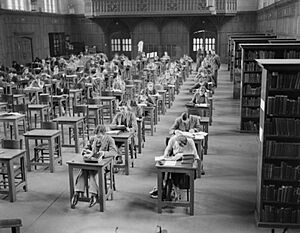
During World War II, most students and staff were moved out of London to places like Bristol. King's buildings were used by the Auxiliary Fire Service, and parts of the college were damaged by bombs during the Blitz. After the war, new laboratories were built.
In 1948, the creation of the National Health Service meant that medical schools like King's were separated from their hospitals. In 1953, the King's College of Household and Social Science became Queen Elizabeth College and started admitting men.
One of the most famous scientific discoveries at King's was the crucial work on the double helix structure of DNA in 1953. Maurice Wilkins and Rosalind Franklin, along with other scientists at King's, made very important contributions to this discovery.
Major rebuilding at King's began in 1966. The Strand Building opened in 1972, and the Macadam Building was built between 1972 and 1975.
Late 20th Century: Independence and Mergers
In 1980, King's became legally independent again with a new royal charter. In 1993, King's and other large University of London colleges started getting money directly from the government and could award University of London degrees themselves. This made King's seem more like its own university.
King's College London went through many mergers in the late 20th century. In 1983, Guy's Hospital Medical School and St Thomas's Hospital Medical School joined together. In the same year, the King's College School of Medicine and Dentistry rejoined King's College. In 1985, Queen Elizabeth College and Chelsea College of Science and Technology also merged with King's.
The Institute of Psychiatry joined King's in 1997. In 1998, the medical schools of Guy's and St Thomas' merged with King's Medical School to form the GKT Medical School within King's College. Also in 1998, Florence Nightingale's famous nursing school joined King's. That same year, King's bought the old Public Record Office building on Chancery Lane and turned it into the Maughan Library, which opened in 2002.
21st century: Modern King's College London

In 2005, King's officially asked for the power to award its own degrees. In July 2006, the government granted King's College London this power. From September 2007, all new students at King's would receive degrees directly from King's, not from the University of London. The first King's degrees were awarded in summer 2008.
In 2007, students from the School of Law won a major international law competition, representing the UK.
In 2009, King's finally achieved a long-held goal: it acquired the east wing of Somerset House. King's got a 78-year lease for the building and raised money to restore it. The renovated East Wing was officially reopened by the Queen in 2012.
In 2010, King's announced some job cuts, including the closure of its Engineering department, which was believed to be the oldest in the UK. In November 2010, King's started a big fundraising campaign to raise £500 million for research in areas like cancer and neuroscience. The Chemistry department, which had closed in 2003, was reopened in 2011.
In 2011, King's became a founding partner in the Francis Crick Institute, a major medical research center.
In October 2014, Ed Byrne became the new Principal of King's College London. In December 2014, King's announced plans to use 'King's London' as a way to promote itself, but these plans were later dropped in January 2015.
On March 10, 2015, King's acquired a 50-year lease for the Aldwych Quarter, which includes the historic Bush House building. King's will use Bush House and other nearby buildings, providing much more space for students, teaching, and academic work.
Historic Buildings of King's College London
The buildings at King's College London, especially at the Strand Campus, are very old and important. These include the main King's Building, built in 1828 to match Somerset House, and the current east wing of Somerset House itself. Both are considered Grade I listed buildings, meaning they are of exceptional historical interest. The Maughan Library and Bush House are also listed buildings. The Strand Campus is part of a special conservation area, protecting its historic character.


